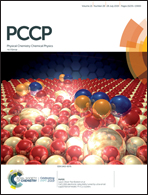CeO2(111) electronic reducibility tuned by ultra-small supported bimetallic Pt–Cu clusters†
Abstract
Controlling Ce4+ to Ce3+ electronic reducibility in a rare-earth binary oxide such as CeO2 has enormous applications in heterogeneous catalysis, where a profound understanding of reactivity and selectivity at the atomic level is yet to be reached. Thus, in this work we report an extensive DFT-based Basin Hopping global optimization study to find the most stable bimetallic Pt–Cu clusters supported on the CeO2(111) oxide surface, involving up to 5 atoms in size for all compositions. Our PBE+U global optimization calculations indicate a preference for Pt–Cu clusters to adopt 2D planar geometries parallel to the oxide surface, due to the formation of strong metal bonds to oxygen surface sites and charge transfer effects. The calculated adsorption energy values (Eads) for both mono- and bimetallic systems are of the order of 1.79 up to 4.07 eV, implying a strong metal cluster interaction with the oxide surface. Our calculations indicate that at such sub-nanometer sizes, the number of Ce4+ surface atoms reduced to Ce3+ cations is mediated by the amount of Cu atoms within the cluster, reaching a maximum of three Ce3+ for a supported Cu5 cluster. Our computational results have critical implications on the continuous understanding of the strong metal–support interactions over reducible oxides such as CeO2, as well as the advancement of frontier research areas such as heterogeneous single-atom catalysts (SAC) and single-cluster catalysts (SCC).

- This article is part of the themed collections: Celebrating recent chemical science in Mexico and 2019 PCCP HOT Articles


 Please wait while we load your content...
Please wait while we load your content...